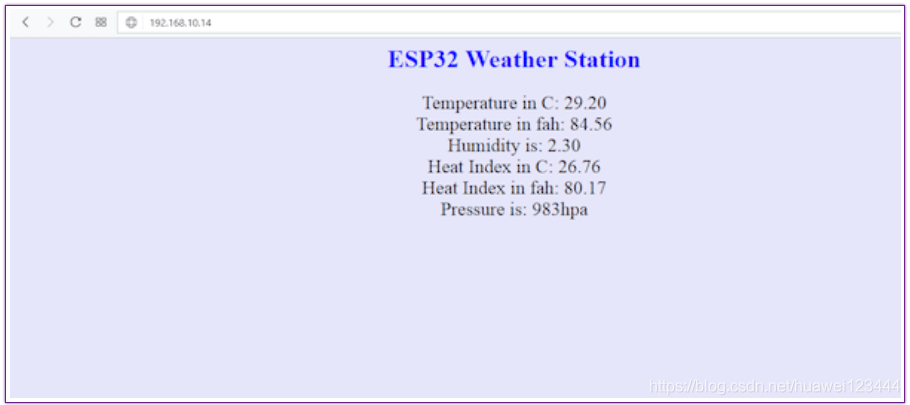-
【毕业设计项目】基于ESP32的家庭气象站系统 - stm32 物联网 嵌入式 单片机
1 简介
Hi,大家好,这里是丹成学长,今天向大家介绍一个学长做的单片机项目
基于ESP32的家庭气象站系统
大家可用于 课程设计 或 毕业设计
单片机-嵌入式毕设选题大全及项目分享:
https://blog.csdn.net/m0_71572576/article/details/125409052
2 主要器件
本项目学长将使用ESP32创建一个气象站。
基本原理是通过读取DHT22和BMP180传感器的数据,然后使用ESP32传输创建的网页上,在网页上显示气象数据。

引脚连接
DHT22与ESP32的连接如下:
DHT22 引脚1 VCC —–>ESP32 / 3.3V;
DHT22 引脚2 DATA—–>ESP32 / D15;
DHT22 引脚4 GND —–>ESP32 /GND.
然后将BMP180压力传感器连接到ESP32上。连接如下:
BMP180 Vin —–> ESP32 / 3.3V;
BMP180 GND —–> ESP32 /GND;
BMP180 SCL —–> ESP32 / pin 22;(ESP32的22号引脚是SCL.)
BMP180 SDA —–> ESP32 / pin 21;(ESP32的21号引脚是SDA.)
ESP32的22和21号引脚是I2C通信接口。
ESP GPIO

3 实现效果
首先,将代码中的Wi-Fi名称和密码信息替换为你自己的。然后上传代码并打开串口监视器。串口监视器将显示如下图所示的IP地址。

在浏览器中输入这个IP地址。输入IP地址后,网页会显示如下图所示。
4 部分实现代码
#include <WiFi.h> #include <Wire.h> #include <DHT.h> #include <Adafruit_BMP085.h> #define DHTPIN 15 #define DHTTYPE DHT22 DHT dht(DHTPIN, DHTTYPE); Adafruit_BMP085 bmp; char pressure_value[4]; const char* wifi_name = "Asus_2.4G"; //Your Wifi name const char* wifi_pass = "basemu.com"; //Your Wifi password WiFiServer server(80); //Port 80 void setup() { Serial.begin(115200); dht.begin(); bmp.begin(); // Let's connect to wifi network Serial.print("Connecting to "); Serial.print(wifi_name); WiFi.begin(wifi_name, wifi_pass); //Connecting to wifi network while (WiFi.status() != WL_CONNECTED) //Waiting for the responce of wifi network { delay(500); Serial.print("."); } Serial.println(""); Serial.println("Connection Successful"); Serial.print("IP address: "); Serial.println(WiFi.localIP()); //Getting the IP address at which our webserver will be created Serial.println("Type the above IP address into a browser search bar"); server.begin(); //Starting the server } void loop() { String pressure = String(bmp.readPressure()); // convert the reading to a char array pressure.toCharArray(pressure_value, 4); float hum = dht.readHumidity(); float temp = dht.readTemperature(); float fah = dht.readTemperature(true); float heat_index = dht.computeHeatIndex(fah, hum); float heat_indexC = dht.convertFtoC(heat_index); WiFiClient client = server.available(); //Checking for incoming clients if (client) { Serial.println("new client"); String currentLine = ""; //Storing the incoming data in the string while (client.connected()) { if (client.available()) //if there is some client data available { char c = client.read(); // read a byte if (c == '\n') // check for newline character, { if (currentLine.length() == 0) //if line is blank it means its the end of the client HTTP request { client.print("<html><title> ESP32 Weather Station</title></html>"); client.print("<body bgcolor=\"#E6E6FA\"><h1 style=\"text-align: center; color: blue\"> ESP32 Weather Station </h1>"); client.print("<p style=\"text-align: center; font-size:150% \">Temperature in C: "); client.print(temp); client.print("<br/>Temperature in fah: "); client.print(fah); client.print("<br/>Humidity is: "); client.print(hum); client.print("<br/>Heat Index in C: "); client.print(heat_indexC); client.print("<br/>Heat Index in fah: "); client.print(heat_index); client.print("<br/>Pressure is: "); client.print(pressure_value); client.print("hpa"); client.print("</p></body>"); break; // break out of the while loop: } else { // if you got a newline, then clear currentLine: currentLine = ""; } } else if (c != '\r') { // if you got anything else but a carriage return character, currentLine += c; // add it to the end of the currentLine } } } } }- 1
- 2
- 3
- 4
- 5
- 6
- 7
- 8
- 9
- 10
- 11
- 12
- 13
- 14
- 15
- 16
- 17
- 18
- 19
- 20
- 21
- 22
- 23
- 24
- 25
- 26
- 27
- 28
- 29
- 30
- 31
- 32
- 33
- 34
- 35
- 36
- 37
- 38
- 39
- 40
- 41
- 42
- 43
- 44
- 45
- 46
- 47
- 48
- 49
- 50
- 51
- 52
- 53
- 54
- 55
- 56
- 57
- 58
- 59
- 60
- 61
- 62
- 63
- 64
- 65
- 66
- 67
- 68
- 69
- 70
- 71
- 72
- 73
- 74
- 75
- 76
- 77
- 78
- 79
- 80
- 81
- 82
- 83
- 84
- 85
- 86
- 87
- 88
单片机-嵌入式毕设选题大全及项目分享:
https://blog.csdn.net/m0_71572576/article/details/125409052
5 最后
-
相关阅读:
【ArcGIS超级工具】基于ArcPy的矢量数据批量自动化入库工具
目标检测——【Transformer】Accelerating DETR Convergence via Semantic-Aligned Matching
springboot视图渲染技术
开放领域对话系统架构
【Python】tqdm 介绍与使用
【springboot】10、处理请求参数
【机器学习】之 K-最近邻(KNN)算法原理及实现
类和对象(3)
KT6368A蓝牙双模芯片关于晶振的选型以及频率误差的测试总结
SQL语句查询关键字
- 原文地址:https://blog.csdn.net/m0_71572576/article/details/125449978